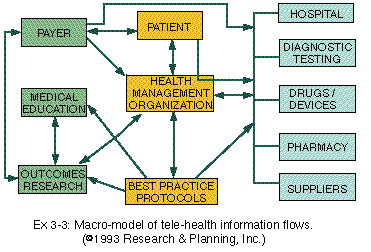
![]()
The agenda of public issues relative to the relationship between telecommunications and transportation extends beyond telecommuting and travel effects to other kinds of impacts. Current government, business, and citizen attention to the development of the National Information Infrastructure is very broad in scope, extending to issues of equity, health care, public education, and government effectiveness, all of which will be considered next.
In fact, the issues can become mixed together in developing workable solutions to real-world problems. An example of such a problem is the lack of jobs and other economic opportunities in inner-city neighborhoods. The problem is often posed as one of transportation for disadvantaged individuals between their homes in the city and the plethora of job opportunities in the suburbs. This issue is the subject of much research (Kasarda, 1993). In fact, pure transportation solutions have not worked very well (Lemov, 1993). An alternative opportunity is to try teleservice delivery of training and other employment support services into inner-city neighborhoods. Delivery points could be located near telecommuting centers offering jobs.
Viewed from the perspective of services provided by telecommunications and
transportation, disadvantaged people are those who are unable without social
services to move from a pattern that includes both closeness to undesirable
conditions and remoteness from desirable conditions. This situation could be
improved through the socially planned and funded deployment of
telecommunications and transportation. Telecommunications applications could be
designed and implemented that are an effective, relatively low-cost channel for
providing disadvantaged people with access in their homes and communities to
education, training, health services, and social services; to jobs and other
economic opportunities; and to information about services and opportunities.
The future health system must depend to a great extent on the electronic delivery and management of health care services and medical practices, utilizing networked information infrastructure technology and applications. New telecommunications applications already beginning to be used will contribute significantly to efficiency and improved care when more widely deployed. Care will be more cost effective when based on electronic access to personal medical records, extensive and current best medical practice information, and consultations delivered by teleconference to the most appropriate location, which might be remote from the health care professional.
Care givers' access through telecommunications to timely and accurate information ensures that the combination of appropriate care and appropriate location is achieved. The model of information flows shown in Exhibit 3-3 illustrates how the health care system, like other service delivery systems, can work better when comprehensively reengineered around the National Information Infrastructure.

![]()
The information system shown in Exhibit 3-3 can be designed to let the overall performance of the medical system be measured and reported to patients and care givers. Preventive care can be included as part of services where that improves performance. The system can be designed to let patients rely more on self-help information to diagnose and treat nonthreatening conditions. Standards of care can be managed to be more consistent from one community to the next, from urban area to rural area, and across the income spectrum.
A confidential electronic medical record-keeping system allows health care providers access to comprehensive family and patient health histories as part of the routine process of diagnosis and prescribing treatment. It will replace the cumbersome and far less complete manual record system, enable faster and more accurate diagnosis, and allow appropriate care at an appropriate location. More complete and timely information can help eliminate mistakes and the need for costly multiple medical tests that are ordered because knowledge of a patient's medical history is incomplete.
A physician, who faces the daunting task of staying current with medical knowledge that grows explosively, will use new on-line services that provide access to current medical literature about the problems diagnosed and best practice treatments.
A restructured health system could, over time, reduce health costs by as much as 25%. At current expenditure levels, savings of $200 billion per year would be realized. Major savings will result as information management practices merge with structural reforms to remove duplication and fragmentation in computer networks. Up to 40% of all hospital costs are related to the generation, storage, and transfer of information.
Significant indirect benefits will result from reform as well. Lower health costs will translate to lower labor costs and fewer jobs lost to countries with more efficient health systems. For the same reason, lower health costs will reduce the price of United States goods and services and improve their competitiveness in world markets. Expanded health care access will reduce the social cost of pain, illness, death, and loss in work productivity. Workers and their families will gain a measure of security as employers use fewer part-time and temporary employees to avoid expensive health benefits. Since health care is a major cost of government, more funds will be available for education and other services or for deficit reduction.
A new health delivery system will produce changes in travel patterns. Exhibit 3-4 illustrates how health care system functions might be divided geographically between rural and urban locations. It also shows how some kinds of critical information are available anywhere through remote electronic database access.
Telecommunications can also expand home health care service access through new attachments to home telephone service, providing consultation and monitoring services as needed, especially to the less mobile elderly population, while reducing the number of trips to health centers. In some cases, tele-health will increase travel as a result of the system transforming to provide higher quality, very specialized services around fewer, more competent centers. Examples are national and regional centers of excellence for advanced procedures, such as open-heart surgery.
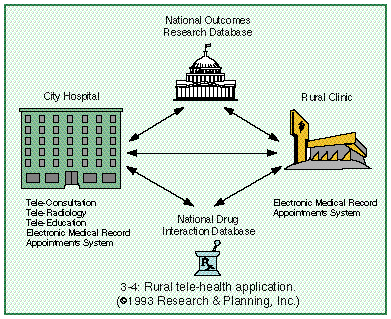
Travel patterns in health care reform are a minor consideration,
however, compared to the potential in cost savings and improved care. As
Exhibits 3-5 and 3-6 illustrate, medical trips per household appear to be
rising again, but they are a small and shrinking component of household travel
overall.
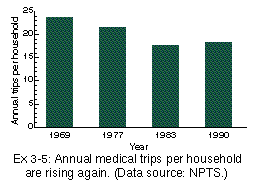
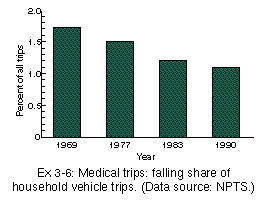
Profound economic and social changes are causing a new reassessment of the form and substance of K-12 education. The expanding National Information Infrastructure is playing a strong, supportive role in that effort. There is a growing recognition that the restructuring of our education system is fundamental to our economic prosperity and personal well being.
In a world where many nations find their competitive advantage in abundant inexpensive human labor, U.S. economic strength lies in the capacity to marshal human intellect more effectively. More citizens must be empowered with skills enabling them to compete with high-wage workers in other technically advanced nations and increasingly with low-wage but high-skill workers in advancing nations.
At the same time, education cannot avoid the social needs of its consumers, our children. Educational performance of schools correlates too closely with the numbers of children from single-parent households or eligible for free meals.
Distance learning, which provides an educational structure for students not in face-to-face contact with a teacher, is an example of the dramatic changes in learning activity resulting from telestructure and teleprocess. Compared to traditional correspondence learning, teleprocessed distance learning allows many different combinations of audio, video, and data exchange and interaction.
As telestructure declines in cost and becomes more ubiquitous, less and less distinction will be made between information technologies that have been separately associated with home, school, and office. This will produce two important consequences: learning will not be constrained to fixed time periods and locations, and transitions from home to school and from school to work environments will be easier.
Telephenomena benefit students and teachers in numerous ways:
The current penetration of teleprocesses used to provide distance learning is shown in Exhibit 3-7. The matrix lists the predominant teleprocess formats and the key telestructure components used to support them. A high degree of choice exists in format and component selection.
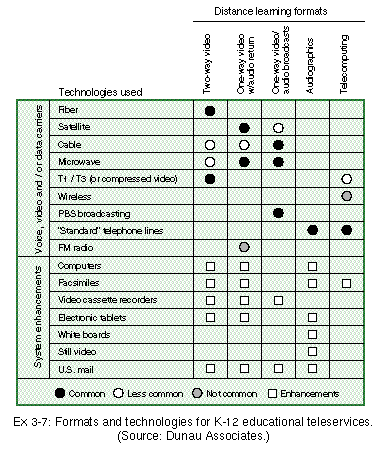
![]()
Though teleprocess is a standard tool used by some educators, there is evidence that it is far from being an integral part of the learning experience. Surveys show that there are serious barriers to the use of teleprocess: lack of hardware, lack of access, insufficient administrative support, lack of time within the school schedule, and lack of professional development opportunities to enable teachers to fully utilize it.
State governments are rapidly increasing their involvement in distance learning systems. By 1991, 46 states had systems in place or were developing strategic plans; however, the rate at which distance learning is made available to administrators, teachers, and students is affected by fragmentation of authority across various state agencies.
The Internet now linking millions of computer users worldwide is the federal government's most significant support to date of telestructure and teleprocess for K-12 and other public services. The National Research and Education Network (NREN), authorized in 1991, builds on the federally funded portion of the Internet. It provides users in government, industry, and education with access to the information resources of libraries, schools, and government research agencies.
The state regulatory environment strongly affects the development of telestructure relating to K-12 education. State public service commissions are debating the fundamental choice between establishing distinct education tariffs at rates below those for business service, to support school use of the public switched network for learning, or else maintaining a strong least-cost service policy for the public as a whole.
The 1990s are likely to see large investments, both public and private, in telestructure and teleprocess that will benefit K-12 education:
There is little focus upon travel savings in the planning for teleprocess that is going on. One interesting observation, noted in Exhibit 3-8, is that the transportation intensity of student services is going up, as shown by the growing per-capita school bus mileage figures.
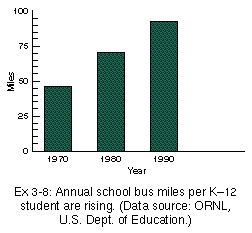
Decisions to introduce new telecommunications in government agencies generally have not been prompted by desires to reduce transportation or to promote telecommuting. Unless an agency specifically intends for telecommunications to affect travel, for institutional reasons it is unlikely to examine the transportation impacts of a new technology, so most of the impacts of telecommunications on transportation must be inferred.
Notable examples of the use of telecommunications have been in the area of document handling, to make it easier for agencies to process the paperwork associated with issuing regulations, granting permits, recording transfers of property, improving the use of information to collect taxes or assessments, and processing claims for benefits. Many of these applications of telecommunications allow agencies to deliver services to clients in a matter of minutes rather than hours and by telephone rather than in person.
As in the case of large private organizations, use of telecommunications in this kind of government application allows work to be done with a smaller staff. Some agencies strive to reassign persons displaced by telecommunications, but others may reduce staffing; in the latter case, the reduction in employees could have as large an effect on travel as the travel savings by clients or from telecommuting by the remaining employees.
Another major application of telecommunications is in inspection, monitoring, enforcement, and other fieldwork activities that are essential parts of many agencies' operations. As examples, remote air-quality monitors and utility meters can be queried by phone, databases can be checked from the field, reports can be filed from the field, and surveillance can be maintained via remote video.
Although some of these applications clearly have the potential to reduce travel by field staff, in most cases telecommunications is introduced to improve staff productivity, and reducing travel just happens to be one way of doing so. The nature of some jobs, such as building inspection and police patrolling, means that the technology will save little if any travel, the real benefits accruing via more rapid processing of forms or via the provision of timely information when a trip back to the agency office would introduce unacceptable delays in staff action. Some introductions of telecommunications, however, may make it possible for agency employees who do not work in the field to telecommute more often once information from field employees is reported, stored, and analyzed in electronic form.
A third area is in the analysis and planning of government operations. Several states have undertaken development of database and analysis systems that allow municipal or county agencies to obtain data rapidly or to perform analyses to improve efficiency. One state now requires local school districts to use a state-supported system to plan school bus routes, and these districts are achieving substantial reductions in bus fuel consumption. Local police agencies have been able to obtain information about crimes, licenses, and vehicle ownership from state databases for years, and efforts are underway to develop improved information systems to coordinate drug enforcement and other activities that involve more than one agency. Again, many of these applications seem unlikely to have much effect on transportation, either to increase it or to decrease it.
The final major area of activity is in information outreach by local governments to their citizens. In many cases, governments rely on information published in newspapers, on mailings, or on contacts initiated by citizens to pass information to citizens. A number of municipalities are experimenting with providing electronic bulletin boards, remote information terminals, or computer information kiosks that citizens can use to find out more about available services or activities, complete applications for licenses, or find out what regulations apply to a proposed activity. Most of these efforts seem unlikely to reduce travel because they often are adding a service that did not previously exist; in some cases, they may increase the amount of travel if citizens learn about a service and decide to use it.
Barriers remain to all of these applications. Many laws, for example, require the signing of documents, the retention of signed documents in vehicles or at construction sites, or the witnessing of document signing; although some agencies have chosen to interpret these requirements loosely, many small legal changes may be needed to allow effective use of telecommunications in some applications.
![]()
Go to:
![]()